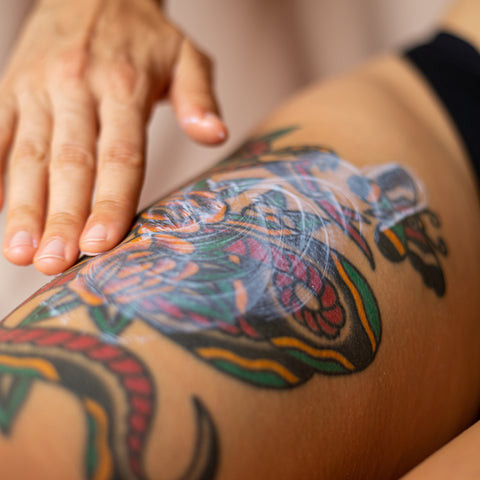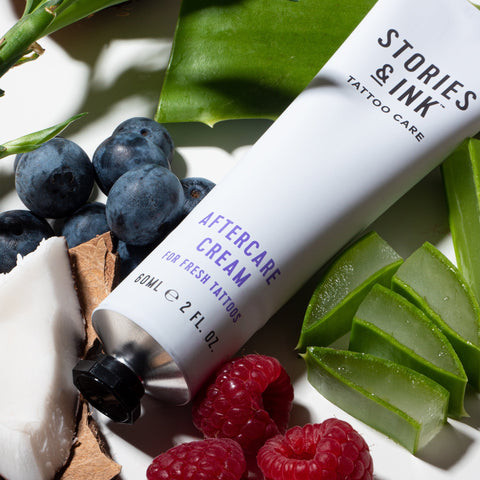Can you over moisturize your tattoo? Yes, over-moisturizing a new tattoo is possible and can hinder the healing process. Understanding the risks and knowing how to properly care for your ink is crucial for maintaining vibrant tattoo art and preventing complications. At tattooat.com, we provide expert advice and curated resources to help you navigate every stage of tattoo aftercare, ensuring your body art remains a stunning expression of yourself. Learn about tattoo care tips, avoiding tattoo damage, and maintaining healthy tattoo vibrancy.
1. Why is Moisturizing Important for Tattoos?
Moisturizing is very important for maintaining the health and appearance of tattoos. It helps keep the skin hydrated, which is essential for proper healing and preventing the ink from fading prematurely. However, it’s a delicate balance, and too much moisture can be detrimental.
1.1 Benefits of Proper Tattoo Moisturizing
Here are some of the many benefits that proper tattoo moisturizing provides:
- Promotes Faster Healing: Keeps the skin supple, aiding the natural healing process.
- Reduces Scabbing: Hydrated skin is less likely to form thick scabs.
- Prevents Itching: Moisturizing can alleviate the discomfort of itchy skin during the healing phase.
- Enhances Ink Vibrancy: Well-moisturized skin helps the tattoo ink stay bright and sharp.
1.2 Risks of Over-Moisturizing
Over-moisturizing can lead to several complications that hinder the tattoo healing process. Understanding these risks can help you strike the right balance in your aftercare routine.
Here are some of the risks associated with over-moisturizing tattoos:
| Risk | Description |
|---|---|
| Clogged Pores | Excess moisture can block pores, leading to breakouts and potentially damaging the tattoo’s appearance. |
| Bacterial Growth | A moist environment encourages the growth of bacteria, increasing the risk of infection. |
| Soggy Scabs | Over-moisturizing can soften scabs, causing them to fall off prematurely and potentially leading to ink loss or scarring. |
| Inflammation and Irritation | Excessive moisture can cause the skin to become irritated, inflamed, and uncomfortable. |
| Delayed Healing | Instead of speeding up the healing process, over-moisturizing can slow it down by disrupting the skin’s natural balance. |
| Ink Blurring | Excess moisture can cause the ink to spread slightly, leading to a blurred appearance of the tattoo. |
2. How Often Should You Moisturize a Tattoo?
The frequency of moisturizing a tattoo is a crucial aspect of aftercare. Typically, moisturizing once or twice a day is sufficient. However, it’s essential to assess your skin’s specific needs and adjust accordingly.
2.1 General Guidelines for Moisturizing
Here’s a general guide for how often to moisturize your tattoo:
- Initial Healing Phase (First Week): Apply a thin layer of moisturizer 2-3 times a day.
- Subsequent Weeks: Reduce to once or twice a day as the tattoo heals.
- Listen to Your Skin: If your skin feels dry, moisturize. If it feels oily, reduce frequency.
2.2 Factors Affecting Moisturizing Frequency
Several factors can influence how often you need to moisturize your tattoo:
- Skin Type: Dry skin may require more frequent moisturizing compared to oily skin.
- Environment: Humid climates may reduce the need for moisturizing, while dry climates may increase it.
- Tattoo Location: Areas that experience more friction (e.g., wrists, ankles) may need more frequent moisturizing.
- Type of Moisturizer: Thicker moisturizers may provide longer-lasting hydration, reducing the need for frequent application.
3. Identifying an Over-Moisturized Tattoo
Recognizing the signs of an over-moisturized tattoo is essential for preventing further complications and ensuring proper healing.
3.1 Common Signs of Over-Moisturization
Look out for these signs of tattoo over-moisturization:
- Excessive Redness: The skin around the tattoo appears unusually red and inflamed.
- Pimple-Like Bumps: Small, raised bumps or breakouts appear on or around the tattooed area.
- Soggy Scabs: Scabs become soft, white, and mushy instead of dry and firm.
- Blurred Ink: The tattoo ink looks faded or blurred.
- Persistent Itching: The tattoo itches excessively, even after moisturizing.
- Shiny Appearance: The skin around the tattoo looks overly shiny and greasy.
3.2 Comparing Over-Moisturized vs. Properly Moisturized Tattoos
| Feature | Over-Moisturized Tattoo | Properly Moisturized Tattoo |
|---|---|---|
| Skin Appearance | Shiny, greasy, excessively red | Hydrated, smooth, normal skin tone |
| Scabs | Soggy, white, mushy | Dry, firm, intact |
| Pores | Clogged, with pimple-like bumps | Clear, normal |
| Ink | Blurred, faded | Sharp, vibrant |
| Itching | Persistent, excessive | Minimal, manageable |
| Overall Condition | Inflamed, irritated, potentially infected | Calm, healing well |
 Over-moisturized tattoo showing redness and irritation
Over-moisturized tattoo showing redness and irritation
Alt text: Close-up of an over-moisturized tattoo showing redness and irritation, indicating a need to adjust aftercare practices.
4. Steps to Fix an Over-Moisturized Tattoo
If you suspect your tattoo is over-moisturized, take immediate action to correct the issue and promote healthy healing.
4.1 Immediate Actions to Take
Follow these steps to address an over-moisturized tattoo:
- Gently Pat Dry: Use a clean, soft cloth or paper towel to gently pat the tattooed area dry. Avoid rubbing, as this can cause irritation.
- Air Exposure: Allow the tattoo to air dry for at least 20-30 minutes. This helps reduce moisture buildup.
- Skip Moisturizing: Refrain from applying any moisturizer for the rest of the day.
- Monitor: Keep a close eye on the tattoo for any signs of infection, such as increased redness, swelling, or pus.
4.2 Adjusting Your Aftercare Routine
Make adjustments to your aftercare routine to prevent future over-moisturization:
- Reduce Frequency: Decrease the number of times you moisturize per day.
- Apply Thin Layer: Use a small amount of moisturizer and apply it in a thin, even layer.
- Use Proper Moisturizer: Choose a tattoo-specific, non-comedogenic moisturizer that won’t clog pores.
- Dry Thoroughly: Ensure the tattoo is completely dry before applying moisturizer.
4.3 When to Seek Professional Help
In some cases, an over-moisturized tattoo can lead to complications that require professional medical attention. Consult a doctor or dermatologist if you experience:
- Signs of Infection: Increased redness, swelling, pain, pus, or fever.
- Severe Breakouts: Extensive pimple-like bumps or boils around the tattoo.
- Spreading Inflammation: Inflammation that extends beyond the tattooed area.
- Persistent Symptoms: Symptoms that don’t improve after adjusting your aftercare routine.
5. Choosing the Right Moisturizer
Selecting the right moisturizer is crucial for tattoo aftercare. The ideal product should be gentle, non-irritating, and specifically formulated to support the healing process.
5.1 Ingredients to Look For
Here are the ingredients you should look for in your moisturizer:
- Natural Oils: Jojoba, coconut, or shea butter to hydrate and nourish the skin.
- Vitamins: Vitamin E or D to promote healing and reduce inflammation.
- Soothing Agents: Aloe vera or chamomile to calm irritated skin.
- Non-Comedogenic: Ensures the moisturizer won’t clog pores.
5.2 Ingredients to Avoid
Here are the ingredients you should try to avoid:
- Fragrances: Can cause allergic reactions and irritation.
- Dyes: Artificial colors can irritate sensitive skin.
- Alcohol: Dries out the skin and can impede healing.
- Petroleum-Based Products: Can clog pores and trap bacteria.
5.3 Recommended Tattoo Moisturizers
| Moisturizer | Key Ingredients | Benefits |
|---|---|---|
| Stories & Ink Aftercare Cream | Natural oils, vitamins, soothing agents | Soothes, calms, and repairs damaged skin; cruelty-free and vegan-friendly |
| Aquaphor Healing Ointment | Petrolatum, lanolin, glycerin | Protects and moisturizes; helps prevent scabbing |
| Eucerin Advanced Repair Cream | Ceramides, natural moisturizing factors | Restores skin’s moisture barrier; fragrance-free and non-irritating |
| Aveeno Daily Moisturizing Lotion | Colloidal oatmeal | Soothes and protects dry, itchy skin; fragrance-free and non-greasy |
| Hustle Butter Deluxe Tattoo Aftercare | Shea butter, mango butter, coconut oil, papaya | Promotes healing, reduces redness, and keeps the skin moisturized; vegan and cruelty-free |
 Stories & Ink Aftercare Cream
Stories & Ink Aftercare Cream
Alt text: Stories & Ink Aftercare Cream, a recommended tattoo moisturizer known for its natural ingredients and soothing properties.
6. Best Practices for Tattoo Aftercare
Proper tattoo aftercare is vital for ensuring your tattoo heals correctly and remains vibrant for years to come.
6.1 Cleaning Your Tattoo
- Wash Gently: Use mild, fragrance-free soap and lukewarm water to gently clean the tattoo.
- Pat Dry: Pat the area dry with a clean, soft cloth or paper towel.
- Frequency: Clean the tattoo 2-3 times a day during the initial healing phase.
6.2 Applying Moisturizer Correctly
- Thin Layer: Apply a thin layer of moisturizer to the clean, dry tattoo.
- Massage Gently: Gently massage the moisturizer into the skin until it’s fully absorbed.
- Avoid Over-Application: Use just enough moisturizer to keep the skin hydrated without making it greasy.
6.3 Protecting Your Tattoo
- Sun Protection: Protect the tattoo from direct sunlight by wearing loose clothing or applying a broad-spectrum, fragrance-free sunscreen.
- Avoid Irritants: Avoid exposure to harsh chemicals, perfumes, and abrasive fabrics.
- Stay Hydrated: Drink plenty of water to keep your skin hydrated from the inside out.
7. Tattoo Healing Stages
Understanding the different stages of tattoo healing can help you provide the appropriate care at each step.
7.1 Stage 1: Initial Healing (Days 1-7)
- Appearance: The tattoo may appear red, swollen, and tender.
- Care: Keep the area clean and moisturized; avoid touching or scratching.
7.2 Stage 2: Itching and Peeling (Days 7-14)
- Appearance: The tattoo may start to itch and peel as the skin regenerates.
- Care: Continue to moisturize; avoid picking at the peeling skin.
7.3 Stage 3: Consolidation (Days 14-30)
- Appearance: The tattoo may look dull or cloudy as the new skin settles.
- Care: Continue to moisturize; protect from sun exposure.
7.4 Stage 4: Long-Term Care (Months 1+)
- Appearance: The tattoo should look vibrant and fully healed.
- Care: Continue to moisturize as needed; protect from sun exposure to prevent fading.
8. Common Tattoo Aftercare Mistakes
Avoiding common tattoo aftercare mistakes can help ensure your tattoo heals properly and looks its best.
8.1 Over-Washing
Washing the tattoo too frequently can dry out the skin and delay healing. Stick to 2-3 times a day.
8.2 Picking or Scratching
Picking or scratching the tattoo can cause scarring, infection, and ink loss. Resist the urge to touch it.
8.3 Using Harsh Products
Using harsh soaps, lotions, or ointments can irritate the skin and impede healing. Stick to gentle, fragrance-free products.
8.4 Sun Exposure
Exposing the tattoo to direct sunlight can cause fading and damage. Protect it with clothing or sunscreen.
8.5 Ignoring Signs of Infection
Ignoring signs of infection can lead to serious complications. Seek medical attention if you notice increased redness, swelling, pain, or pus.
9. Addressing Specific Skin Types
Different skin types may require slightly different tattoo aftercare approaches.
9.1 Oily Skin
- Moisturize Sparingly: Use a lightweight, non-comedogenic moisturizer.
- Clean More Frequently: Wash the tattoo more often to remove excess oil.
9.2 Dry Skin
- Moisturize Generously: Use a thicker, more emollient moisturizer.
- Hydrate Internally: Drink plenty of water to keep the skin hydrated from the inside out.
9.3 Sensitive Skin
- Choose Hypoallergenic Products: Use fragrance-free, dye-free, and hypoallergenic products.
- Patch Test: Test new products on a small area of skin before applying them to the tattoo.
9.4 Combination Skin
- Balance Moisturizing: Use a lightweight moisturizer on oily areas and a richer moisturizer on dry areas.
- Monitor Skin: Pay attention to how your skin responds and adjust your routine accordingly.
10. Advanced Tattoo Care Techniques
For those looking to take their tattoo care to the next level, consider these advanced techniques.
10.1 Using Tattoo Balms
Tattoo balms are specially formulated to nourish and protect tattooed skin. Look for balms with natural ingredients like shea butter, coconut oil, and vitamin E.
10.2 Incorporating Tattoo Serums
Tattoo serums can help improve the appearance of tattoos by hydrating, brightening, and protecting the skin. Look for serums with antioxidants and anti-inflammatory ingredients.
10.3 Regular Skin Exfoliation
Gentle exfoliation can help remove dead skin cells and reveal brighter, more vibrant tattoo ink. Use a mild exfoliating scrub or a soft washcloth.
10.4 Professional Tattoo Care Consultations
Consider consulting with a tattoo artist or dermatologist for personalized advice on how to care for your specific tattoo and skin type.
FAQ: Can I Over Moisturize My Tattoo?
1. Can I really over-moisturize my tattoo?
Yes, it’s possible. Over-moisturizing can lead to clogged pores, bacterial growth, and delayed healing.
2. How do I know if I’m over-moisturizing my tattoo?
Signs include excessive redness, pimple-like bumps, soggy scabs, and blurred ink.
3. What should I do if I’ve over-moisturized my tattoo?
Gently pat the area dry, allow it to air dry, and skip moisturizing for the rest of the day.
4. How often should I moisturize my new tattoo?
Generally, 2-3 times a day during the initial healing phase, then reduce to once or twice a day.
5. What kind of moisturizer should I use on my tattoo?
Choose a tattoo-specific, fragrance-free, non-comedogenic moisturizer with natural ingredients.
6. Can over-moisturizing cause a tattoo infection?
Yes, a moist environment can promote bacterial growth, increasing the risk of infection.
7. Is it better to keep a tattoo dry or moisturized?
A balance is needed. Keep the tattoo clean and moisturized, but avoid excessive moisture.
8. Can I use regular lotion on my tattoo?
It’s best to use a lotion specifically designed for tattoos or a gentle, fragrance-free lotion.
9. How long should I moisturize my tattoo after getting it?
Continue moisturizing as needed, even after the tattoo is fully healed, to keep the skin hydrated and the ink vibrant.
10. When should I see a doctor about my over-moisturized tattoo?
Seek medical attention if you experience signs of infection, severe breakouts, or spreading inflammation.
Remember, the art of tattoo aftercare involves striking a delicate balance. While moisturizing is essential for promoting healing and maintaining vibrancy, overdoing it can lead to complications. By understanding the risks, recognizing the signs, and following the best practices outlined in this guide, you can ensure your tattoo heals beautifully and remains a stunning expression of your personal style for years to come.
Ready to explore more tattoo designs, find talented artists, and dive deeper into tattoo culture? Visit tattooat.com today and unlock a world of inspiration and expertise. Whether you’re considering your first tattoo or adding to your collection, tattooat.com is your ultimate resource for all things ink. Discover designs, connect with artists, and learn how to keep your tattoos looking their best. Join our community today and celebrate the art of self-expression!
Address: 1825 SW Broadway, Portland, OR 97201, United States
Phone: +1 (503) 725-3000
Website: tattooat.com
